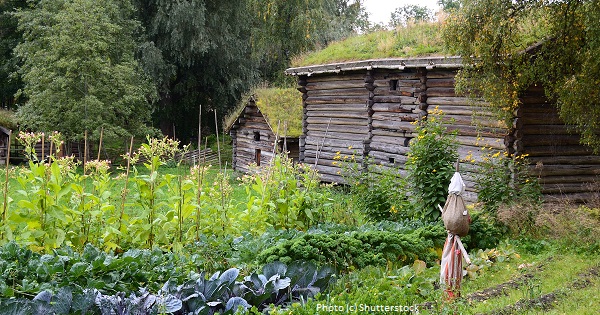|

Permaculture: The Forest Garden
Self-sustaining food, fiber, and energy producing ecosystems
by Grégoire Lamoureux
Permaculture is about designing sustainable human environments. By gradually moving from an annual to a perennial system, the process becomes more self-sustaining. Annuals will produce more and faster, but the input required for growing is higher than for perennials. Trees are perhaps the ultimate perennial, and the forest garden is an important aspect of permaculture.
Getting Started
In any garden, the soil needs to be prepared and fertile, and the seeds need to be put at the right time; then enough moisture is needed for germination and the growth of healthy seedlings. Often, some thinning is needed and either mulch or compost added again before the harvest. Water is essential for most annuals. Then you have to collect the seeds (and some annuals need isolation to prevent cross-pollination), otherwise you have to go out and buy more seeds. So growing with annuals is a high-input/high-output system that can be used at the early stage of development of the design.
One strategy used is to let some of the annuals go through their whole cycle, flowering and then producing seeds. Some can be collected, others will fall to the ground where they will sprout and start growing when the environment is favorable. In this way, some annuals can become perennials.
Using more perennials in your permaculture forest garden design will help in the long run to have a more sustainable system, by cutting down on the amount of work needed to maintain the plants. Perennials don't need to be seeded or planted every year. They often require less water by having a well-established root system that can get the amount of moisture required from the subsoil. Some will need a minimum of pruning annually, or once in a while.
You can also integrate a group of plants – often called a “guild” – that will work in cooperation with each other. An example would be having fruit trees surrounded by nitrogen fixing plants or shrubs, like clover or caragana (Siberian pea shrub) that fixes nitrogen from the air into the soil and makes it available to other plants through a symbiotic relationship using mycorrhizal (myco=fungus, rhyza=root) bacteria as mediator. As the shrub or plants get bigger they can be cut down or pruned and the prunings mulched back on the soil to help build up organic matter. At the same time some of the roots will die back and add more nutrients to the soil. This process helps keep the level of fertility very high.
Another means of keeping the fertility high is by using deep rooted plants such as daikon, or horseradish, which bring up nutrients from the subsoil to the surface. Within our guild we also need to have “insectary” plants, or plants that will attract beneficial insects to control the pest population or plants that keep away insect pests. Some good examples are the umbelliferae family (dill, fennel, carrot, parsnip, etc.), which attract the predatory wasp that lay eggs in the larvae of other pest insects and feed on them. Another example is the compositae family, such as the daisy. Many herbs also have useful purposes in the garden or orchard.
The forest garden concept originated with Robert Hart, who wrote Forest Gardening in 1991. His work as been inspired by J. Russell Smith's Tree Crops: A Permanent Agriculture, and he was also co-author with J. Sholto Douglas of Forest Farming (1976). Both models, forest gardening and forest farming, preceded permaculture and permaculture has evolved from them.
The concept of forest gardening is to design a system that uses a diversity of plants to produce food, fuel, fibers, timber, medicines and other products in a sustainable way. Such a system is resilient in the face of climate irregularities, pests, and diseases, utilizes growing space to a maximum, benefits the environment by reducing atmospheric carbon dioxide, and provides other less tangible, moral and spiritual benefits.
The permaculture forest garden can be designed and will evolve using a series of principles such as diverse polycultures, emphasis on perennials, use of succession in both establishment and yield, dense multi-story plantings (stacking), little or no cultivation of soil, using multi-functional plants, animals, and structures, matching yields and needs of the elements in the system for mutual benefit, and also by maintaining close interaction between the resident/designer and the garden, as well as by observation.
The Layers
Like the forest, the garden can integrate some clearings with many edges where there is enough light for growing most vegetable crops. It will also use the space efficiently by having plants growing at all the layers such as:
-
Canopy or large trees for larger fruit or nut trees.
-
Small trees for semi-dwarf varieties of fruit trees or other smaller food producing or timber trees.
-
Shrubs may be fruits and nuts on dwarfing rootstocks, bush fruit such as currants, gooseberries, etc.
-
Herbaceous perennials such as herbs, flowers, insectary plants.
-
Ground covers may be creeping plants such as creepy thyme, strawberries.
-
The vertical layer may be climbing berries, kiwis, vines crops.
-
The rhizosphere can be used for shade-tolerant root crops such as daikon, horseradish and many bulbs.
-
There is also the epiphyte layer, such as mosses and lichens that grow on trees that can be harvested and used as mulch or craft material.
Plants are chosen for their pest and disease resistance, compatibility, and suitability for the site conditions. Once established, the garden should be an extremely stable system, needing few inputs. And you will get a lot of pleasure at harvesting the abundance and diversity of a permaculture forest garden.
Grégoire Lamoureux is the Director of the Kootenay Permaculture Institute, Winlaw BC.
|

